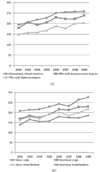Abstract
Purpose
To analyze trends in salaries for registered nurses when compared with salaries for elementary school teachers from 2002 to 2009 and identify salary gaps of nurses according to workplace size and geographic location.
Methods
Data were obtained from the Occupational Employment Statistics collected by the Korea Employment Information Services each year from 2002 to 2009. The study sample consisted of 2,281 registered nurses and 2,578 elementary school teachers. Linear multiple regression analyses were conducted to analyze salary trends and differences.
Results
Elementary school teachers had higher monthly salaries than nurses with a baccalaureate degree after adjusting for years of work. Salary differences increased significantly by 40,000 won every year (p<.001). Nurses working in large facilities in Seoul had the highest salaries, whereas those in small/medium, non-Seoul facilities had the lowest salaries consistently over time. Salary differences between the two groups increased by 47,000 won every year (p=.001); salary differences between nurses in large, non-Seoul facilities and those in small/medium, non-Seoul facilities also increased by 40,000 won annually (p=.001).
Figures and Tables
 | Figure 1Least-square means of monthly salaries (unit=10,000 won).
(A) Registered Nurses (RNs) and elementary school teachers after adjusting for years worked (=8 years)
(B) Registered Nurses (RNs) by workplace after adjusting baccalaureate degree and 8 years worked
|
Table 1
Characteristics of Registered Nurses (RNs) and Elementary School Teachers by Education and Workplace (N=4,859)

Table 2
Monthly Salary of Registered Nurses (RNs) and Elementary School Teachers by Education and Workplace (N=4,859; Unit=10,000 won)

References
1. Buerhaus PI. The potential imposition of wage controls on nurses: A threat to nurses, patients, and hospitals. Nurs Econ. 2008. 26(4):276–279.
2. Charles JP, Piper S, Miley SK, Davis P, Baigis J. Nurse salaries in Washington DC and nationally. Nurs Econ. 2000. 18(5):243–249.
3. Cho SH, June KJ, Kim YM, Park BH. Changes in hospital nurse staffing after implementing differentiated inpatient nursing fees by staffing grades. J Korean Acad Nurs Adm. 2008. 14:167–175.
4. Cho SS, Son YS. Time series analysis using SAS/ETS. 2011. Seoul: Yulgok Publish.
5. England P, Pudig M, Folbre N. Wage of virtue: The relative pay of care work. Soc Probl. 2002. 49:455–473. http://dx.doi.org/10.1525/sp.2002.49.4.455.
6. Friss L. Nursing studies laid end to end form a circle. J Health Polit Policy Law. 1994. 19:597–631. http://dx.doi.org/10.1215/03616878-19-3-597.
7. Grumbach K, Ash M, Seago JA, Spetz J, Coffman J. Measuring shortages of hospital nurses: How do you know a hospital with a nursing shortage when you see one? Med Care Res Rev. 2001. 58:387–403. http://dx.doi.org/10.1177/107755870105800401.
8. Harris DN, Adams SJ. Understanding the level and cause of teacher turnover: A comparison with other professions. Econ Educ Rev. 2007. 26:325–337. http://dx.doi.org/10.1016/j.econedurev.2005.09.007.
9. Heo S. Regional wage differentials in Korea: The case of metropolitan and non-metropolitan areas. Rev Bus Econ. 2007. 20:1–16.
10. Hospital Nurses Association. 2004 Survey of working condition of hospital nurses. 2005. Seoul: Author.
11. Kankaanranta T, Rissanen P. The labor supply of registered nurses in Finland: The effect of wages and working conditions. Eur J Health Econ. 2009. 10:167–178. http://dx.doi.org/10.1007/s10198-008-0116-3.
12. Kim MA, Park KO, You SJ, Kim MJ, Kim ES. A survey of nursing activities in small and medium size hospitals: Reason for turnover. J Korean Clin Nurs Res. 2009. 15:149–165.
13. Kim YM. Nurse staffing level relating factors of the general nursing units, ICU, ER and OR in acute general hospitals. J Korean Acad Nurs Adm. 2008. 14:404–412.
14. Kim YM, Cho SH, June KJ, Go SK. The effects of institutional and market factors on nurse staffing in acute care hospitals. Korean J Health Policy Adm. 2007. 17:68–90.
15. Korea Employment Information Services. Occupational employment statistics user's guide. 2009. Seoul: Author.
16. Kwon JS, Son IS, Park DI, Cho SH, Han YH, Park KS, et al. 2009 Survey of working condition of hospital nurses. 2010. Seoul: Hospital Nurses Association.
17. Lankshear AJ, Sheldon TA, Maynard A. Nurse staffing and healthcare outcomes: A systematic review of the international research evidence. ANS Adv Nurs Sci. 2005. 28:163–174.
18. Lee SH. The direction of policy support for solving crisis of small-medium hospital. 2008. 11. 12. Retrieved June 1, 2012. from http://www.bktimes.net/detail.php?number=12287&thread=16.
19. Lee SH. Determinants and wage effects of inter-regional migration in Korea. J Korean Reg Sci Assoc. 2010. 26(1):45–70.
20. Livine L. The gender wage gap and pay equity: Is comparable worth the next step? 2001. Washington DC: Congressional Research Service Report.
21. Ministry of Health and Welfare. Ministry of health and welfare year book 2011. 2011. Seoul: Author.
22. Nam KS. The analysis of job characteristics using occupational employment statistics. Paper presented at the Symposium of 6th Korea Employment Information Service, Seoul, Korea. 2007. 12.
23. Oh YH. The demand and supply of registered nurses in Korea and policy recommendations. Health Soc Welf Rev. 2008. 28(1):68–86.
24. Park BH. Evaluation of policy related to expansion of hospital nurses. 2012. Seoul National University: Seoul, Korea;Unpublished doctoral dissertation.
25. Park HO. An analysis of the factors determining salary level of hospital. J Korean Acad Nurs Adm. 2008. 14:467–476.
26. Park YW, Lee ES, Lee JS, Cho SH, Ham HM. 2010 Survey of working condition of hospital nurses. 2012. Seoul: Hospital Nurses Association.
27. Robinson JC. Market structure, employment, and skill mix in the hospital industry. South Econ J. 1988. 55:315–325.
28. Shin HS, Lee KH. The issues and improvements of the teacher compensation policy. J Polit Educ. 2008. 15(2):101–125.
29. Spetz J. The value of education in a licensed profession: The choice of associate or baccalaureate degrees in nursing. Econ Educ Rev. 2002. 21:73–85. http://dx.doi.org/10.1016/S0272-7757(00)00047-9.
30. Yang JH, Kwon YJ, Baek YS, Lee ES. The study of turnover intention of nurses. Inje J. 2005. 20(1):609–628.




 PDF
PDF ePub
ePub Citation
Citation Print
Print




 XML Download
XML Download